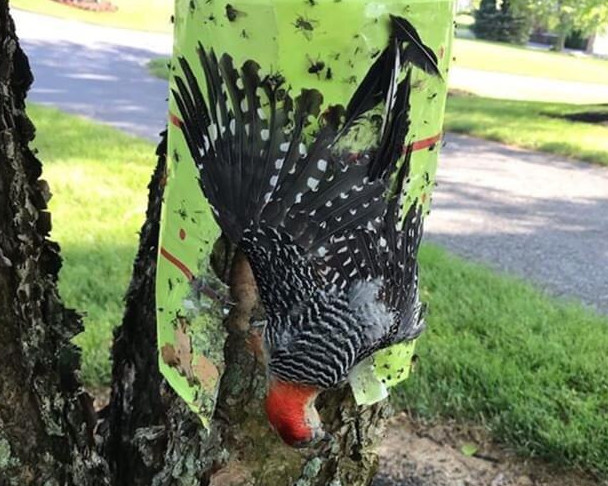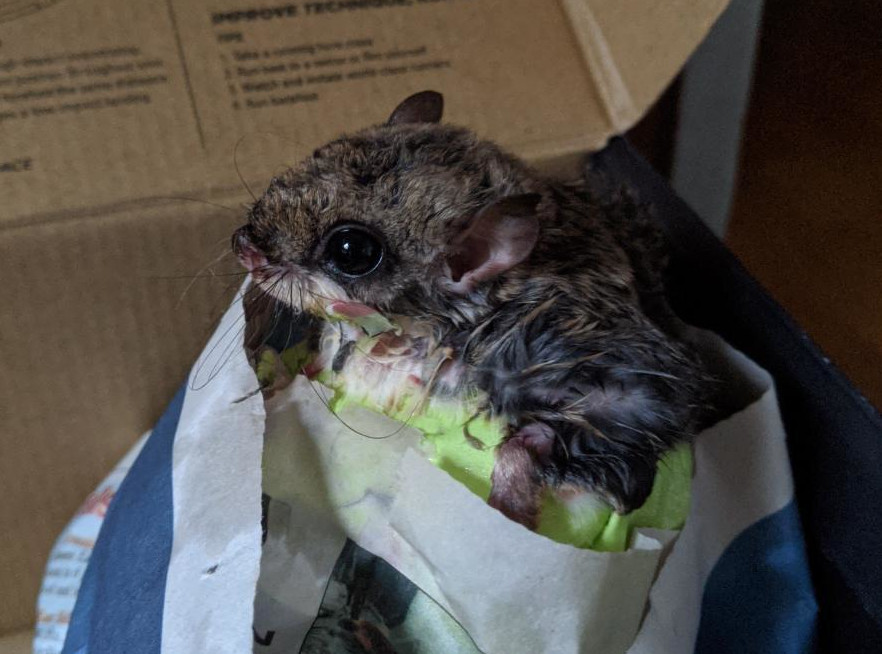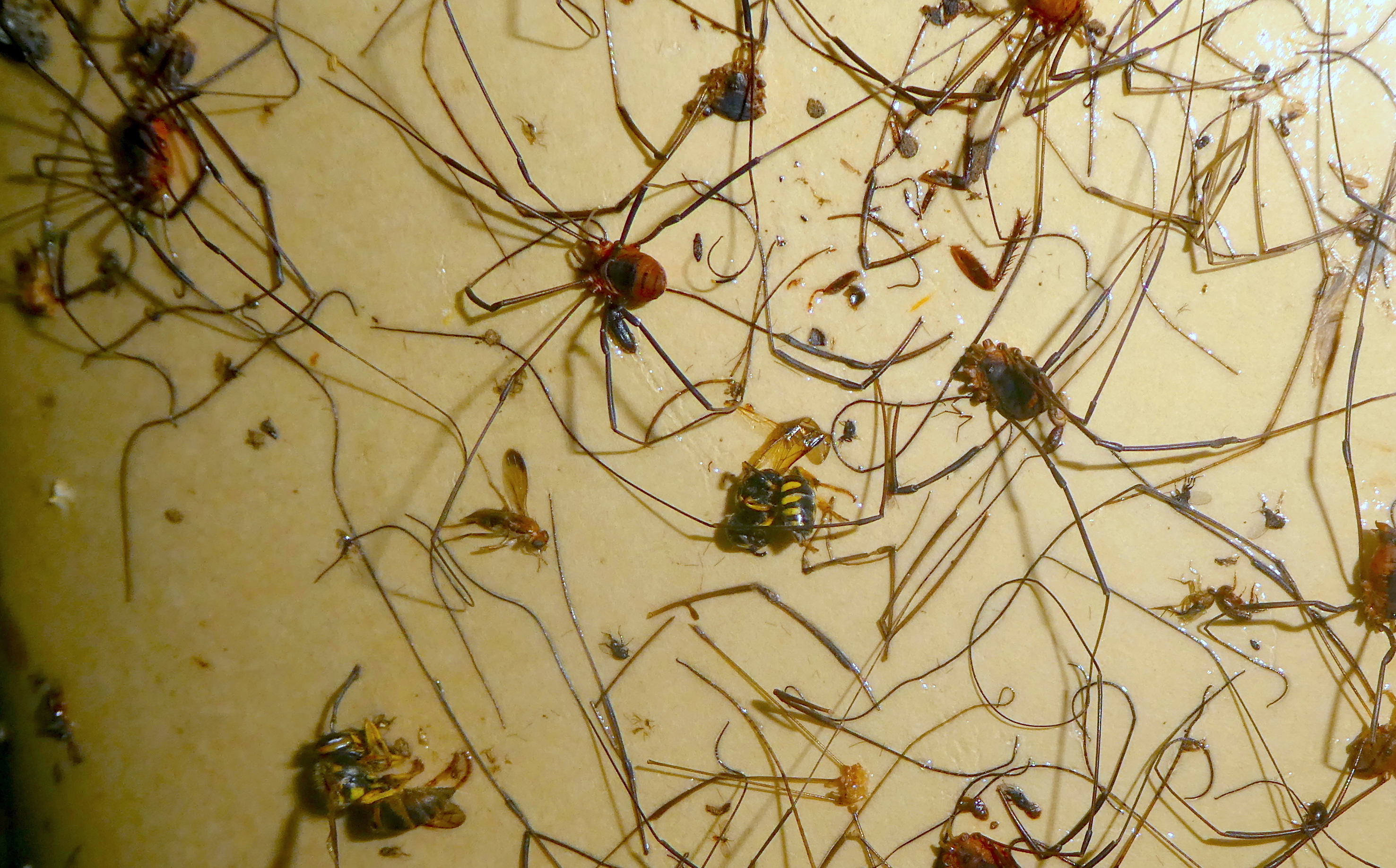SAY NO TO STICKY TAPE!
MORE THAN LANTERNFLIES GET TRAPPED
Birds, mammals, and more get trapped and many don’t survive even if taken to rehab



See below for image credits
See more sticky trap victims at Lehigh Valley Audubon’s Glue Victim’s Gallery
Predators of lanternflies are victims as well, decreasing our chance of controlling the lanternfly population



See below for image credits
See more lanternfly predators at the Spotted Lanternfly Predation Project on iNaturalist. If you spot any instance of predation or parasitism of Spotted lanternflies in the United States, be sure to contribute to that project.
Why are we trapping lanternflies?
Spotted lanternflies are an invasive insect that is a recent arrival in the US. Due to their sheer number they can be a nuisance and can damage certain plants though they are usually not a threat to home gardens. While we’re past the time to stop their spread, we might be able to protect a susceptible and favored tree in our yard by using one of the methods listed in the ‘What can I do instead’ section. Know that we are not going to eradicate them by our individual actions, and it’s time to rely on the predators and parasites listed above.
What can I do instead?
- Use circle traps
- Get rid of Ailanthus trees and other invasive plants
- Scrape and destroy egg masses
- Use physical methods like squashing, vacuums, or getting them to jump into soapy water
- Check out our list of some safer alternatives
- See Colin Purrington’s website for even more control measures
How can I spread the word about the horrors of sticky tape?
- Urge your family, friends and neighbors to stop using sticky tape
- Share our informational flyer, postcard and other material (coming soon)
- Engage with people on social media and recommend that people don’t use sticky tape and suggest alternatives
Frequently Asked Questions
Where can I get a circle trap?
- Great Lakes IPM has a circle trap that you can order from their website. For instructions on assembly, check this video by Lancaster County Conservation District.
- You can make your own by following the instructions on the Penn State Extension website.
What about sticky tape covered with chicken wire or hardware cloth?
While better than completely exposed sticky tape, it is still not recommended since birds and mammals can still get trapped, especially those looking for an easy meal. This also offers no protection for other beneficial insects and arachnids including those that prey on spotted lanternflies.
What do lanternfly eggs look like and what can I do about them?
Spotted lanternfly eggs look like a dried up paste, mud or mortar spread unevenly on a surface. This is often seen on trees, but can be on other surfaces like brick, wooden poles, or even your vehicle. To get rid of the eggs, simply scrape them off with something like a credit card into a bag or other container filled with alcohol. You cannot simply scrape them off onto the ground because they will still hatch. Be sure that what you are scraping off are lanternfly eggs though. Sometimes lichen can be mistaken for lanternfly eggs and we don’t want to scrape that off.


What do the nymphs and adults look like?
Early stage nymphs are black with white spots. As they get older, they are red with some black and white patches. The nymphs cannot fly but they can hop pretty far and quickly. The adults have pale pinkish-brown wings with small black dots. They can fly but are not strong fliers. When they fly, you’ll often see a flash of red. If you are destroying these, be sure that what you are killing are lanternflies. Many other insects and even jumping spiders are often mistaken by people for lanternflies and end up as collateral damage. In the midst of an insect apocalypse, the last thing we want to do is mistakenly kill lots of insects.



Do I have to kill a lanternfly if I see one?
Not necessarily. In the early stages of the infestation when their numbers were lower, killing all lanternflies you saw might have stopped their spread. But currently in many counties in eastern PA and other places, where there are large numbers of spotted lanternflies already, for every one lanternfly you kill there are probably hundreds higher up in the trees that you don’t see. Killing every one you see is not going to eradicate these insects and we are going to have to rely on natural predators like the ones listed above or some other large scale and targeted control method. But you can use the control methods listed on this page to protect a susceptible or favored tree from spotted lantermflies.
What do I do if i find a bird or mammal stuck to tape?
If you find an animal stuck to the tape, DO NOT attempt to remove it yourself, but cover the sticky portions, cut the tape off the tree and bring it, with the animal still stuck on it, to a wildlife rehabber. For a list of wildlife rehabbers in Pennsylvania: https://pawr.com/
Credits
Images
- Red-bellied Woodpecker in tape: / Cropped from original
- Flying squirrel: Used with permission from Peg Shaw / Cropped from original
- Arthropods in sticky tape: Used with permission from Anne Bekker / Cropped from original
- Spotted Orbweaver with lanternfly prey: Used under CC0 by bugbird / Cropped from original
- Red-bellied Woodpecker with lanternfly prey: Used with permission from Martin Dellwo (All rights reserved) / Cropped and brightened from original
- Harvestman with lanternfly prey: George Pushkal / Cropped from original
Lehigh Valley Audubon Society’s Bird ByCatch page for additional information and links